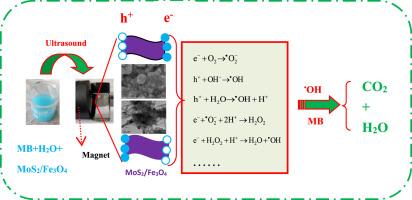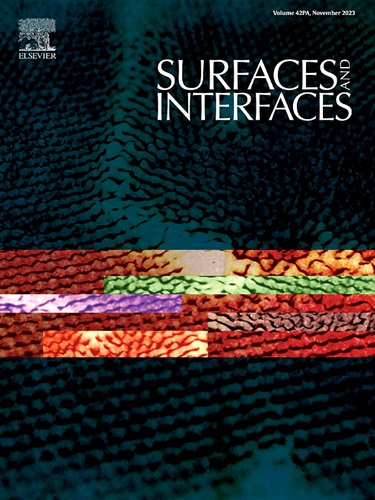Magnetic recyclable MoS2/Fe3O4 piezoelectric catalysts for highly efficient degradation of aqueous pollutants
IF 5.7
2区 材料科学
Q2 CHEMISTRY, PHYSICAL
引用次数: 0
Abstract
As a new type of advanced oxidation processes, simple and easy to implement with less energy consumption, piezoelectric catalytic degradation technology has attracted much attention in recent years. However, the low degradation activity of piezoelectric catalysts and the problem of recycling limit their wide application in the actual degradation of wastewater. In this work, a series of MoS2/Fe3O4 nanocomposite with different MoS2 to Fe3O4 mole ratios were prepared using a facile two-step hydrothermal-precipitation method. The piezocatalytic performance of the obtained composite was investigated through piezocatalytic degrading azo-dye methylene blue (MB) and diclofenac sodium (DCF) in artificial solution, as well as antibiotic resistance genes (ARGs) in swine wastewater. The optimum mole ratio of MoS2 to Fe3O4 was 1:1, by which MB degradation was completed in 6 min with a pseudo-first-order rate constant as high as 0.445 min-1, which was about 2.2 times that of pure MoS2 (0.202 min-1). Moreover, the hybrid material displayed excellent reusability and good stability. The MoS2/Fe3O4 piezocatalytic system can also efficiently degrade both DCF (100 % removal in 15 s) and ARGs (> 99 % in 8 min).The electron paramagnetic resonance characterization and free radical scavenging experiments display that •OH and •O2– were the major active free radicals in the piezocatalysis process and •OH was the dominant species. The piezoresponse force microscopy characterization and electrochemical test demonstrate that MoS2/Fe3O4 has higher piezoelectric response than pure MoS2, of which a plausible mechanism is proposed.

用于高效降解水污染物的磁性可回收 MoS2/Fe3O4 压电催化剂
作为一种新型的高级氧化工艺,压电催化降解技术简单易行,能耗较低,近年来备受关注。然而,压电催化剂较低的降解活性和回收利用问题限制了其在实际废水降解中的广泛应用。本研究采用两步水热沉淀法制备了一系列不同 MoS2 与 Fe3O4 摩尔比的 MoS2/Fe3O4 纳米复合材料。通过压电催化降解人工溶液中的偶氮染料亚甲基蓝(MB)和双氯芬酸钠(DCF)以及猪废水中的抗生素耐药基因(ARGs),考察了所获复合材料的压电催化性能。MoS2 与 Fe3O4 的最佳摩尔比为 1:1,在 6 分钟内完成对 MB 的降解,伪一阶速率常数高达 0.445 min-1,约为纯 MoS2(0.202 min-1)的 2.2 倍。此外,该杂化材料还具有出色的可重复使用性和良好的稳定性。电子顺磁共振表征和自由基清除实验表明,-OH 和-O2-是压催化过程中的主要活性自由基,其中-OH 是优势自由基。压电响应力显微镜表征和电化学测试表明,MoS2/Fe3O4 比纯 MoS2 具有更高的压电响应,并提出了合理的机制。
本文章由计算机程序翻译,如有差异,请以英文原文为准。
求助全文
约1分钟内获得全文
求助全文
来源期刊

Surfaces and Interfaces
Chemistry-General Chemistry
CiteScore
8.50
自引率
6.50%
发文量
753
审稿时长
35 days
期刊介绍:
The aim of the journal is to provide a respectful outlet for ''sound science'' papers in all research areas on surfaces and interfaces. We define sound science papers as papers that describe new and well-executed research, but that do not necessarily provide brand new insights or are merely a description of research results.
Surfaces and Interfaces publishes research papers in all fields of surface science which may not always find the right home on first submission to our Elsevier sister journals (Applied Surface, Surface and Coatings Technology, Thin Solid Films)
 求助内容:
求助内容: 应助结果提醒方式:
应助结果提醒方式:


